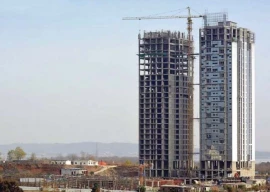
The Sindh government’s development budget for fiscal year 2013 does not even try to hide its political undertones: nearly half of the development spending directly controlled by the provincial government will go to projects requested by politicians ahead of what is expected to be a spirited election season.
The total development outlay for Sindh in fiscal 2013 is Rs231 billion, up by an astonishing 48.3% from the 2012 development spending. But not all of that money is in the control of the Sindh government. About Rs35.7 billion is being spent on projects funded by foreign donors, a category of spending that often reflects the spending priorities of foreign capitals rather than the provincial government itself. The federal government has another Rs14.5 billion in projects that reflect Islamabad’s policy goals.
Of the remaining Rs181 billion, about Rs87.4 billion – or 48% of what Sindh actually controls – is going towards projects with a political bent in mind. In the main budget document, they were listed with vague-sounding headings like “Special Project” with has about Rs24 billion allocated to it, or “Block Allocation to Priority Programme” which gets another Rs12 billion.
The details of these were to be found in the 4,145-page document that details the development budget. The priority programme, it turns out, is Rs60 million that every one of the 168 members of the Sindh Assembly gets to spend more or less as they wish. This amount is typically used by many members to fund projects in their home constituencies.
Sindh Governor Ishratul Ibad has been allocated Rs1 billion to spend on projects as he wishes. Another Rs3 billion goes to Chief Minister Qaim Ali Shah’s personal prerogative. These allocations essentially function as taxpayer-funded political war-chests for incumbent politicians who can appear magnanimous to their constituents at government expense, a particularly useful asset in an election year. Such allocations are common throughout Pakistan and even in other democracies around the world. Yet the Sindh government appears to have gone further than any other provincial government in the country this year.
These politically directed expenditures – which have risen by a whopping 144% in the 2013 budget compared to the previous year – come at the expense of spending elsewhere. Spending on infrastructure, for instance, has been slashed by nearly 51%. Housing has been its budget cut by 5.3% in 2013. Agriculture gets almost the exact same amount as last year, despite 11% inflation, and the police and judicial system get a paltry 2.3% more. In inflation adjusted terms, that amounts to a cut in the public safety budget.
The development budget allocations given to the politicians are also meant to be spent on infrastructure, education, health and the like. But given the fact that these amounts are much smaller – and directed by politicians seeking re-election rather than technocrats acting in accordance to a long-term development strategy – the spending is likely to be on projects that yield few long-term benefits to Sindh’s economy.
For instance, the Sindh government is spending less than Rs13.5 billion ($145 million) on developing the Thar coalfields, arguably the province’s single biggest energy resource which needs at least $12 billion in investment to begin providing electricity to the national grid. The government will spend only Rs500 million on the Khairpur Special Economic Zone, which aims to take advantage of the district’s competitive advantages in agriculture and allow small businesses to get into more value-added products – increasing productivity and incomes for the people of the district.
And local governments have been allocated precisely zero rupees to spend on development on their own discretion, suggesting that the provincial government does not intend to devolve powers down to the district and sub-district levels.
Published in The Express Tribune, June 12th, 2012.
COMMENTS (1)
Comments are moderated and generally will be posted if they are on-topic and not abusive.
For more information, please see our Comments FAQ










1614423942-7/-ET-Burns-Road-by-Athar-Khan-(8)1614423942-7-270x192.webp)






Tell me again why we have a governor & a chief minister at the same time?